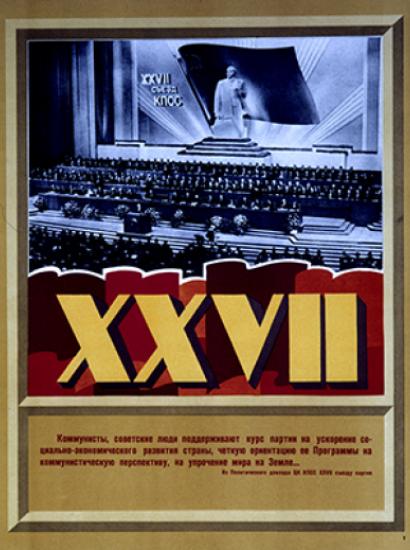
October is the month for bringing in the harvest and consolidating power.
According to his biography on the Gorbachev Foundation website, the last leader of the Soviet Union is proud of his ability to detect a fault in a combine harvester just by the sound of it. His acumen with agricultural machinery—learned from his father—helped the younger Gorbachev become the youngest winner of the Order of the Red Banner of Labor award for his part in bringing in the bumper crop of 1949 at the age of just seventeen. The award helped secure him a place at the Moscow State University, where he studied law.
Gorbachev brought in his own political bumper crop in October 1988, when he was able to consolidate his power by securing election to the chairmanship of the Presidium of the Supreme Soviet. But like agriculture in the Soviet era, it was a hollow triumph, coming just a year before the fall of the Berlin Wall set in motion the final dissolution of the Soviet Union. Despite the titular power, the Communist Party was obstructing the economic reforms of Gorbachev’s perestroika policy, and both Eastern European countries and republics with historical ties to Moscow were growing restless with the economic hardship of the Communist system.
Previously, October had been a bad month for Gorbachev. As the newly-elected General Secretary of the Communist Party of the Soviet Union, Gorbachev left the Geneva Summit with U.S. President Ronald Reagan in October 1985 without a nuclear arms reduction agreement. The October 1986 Reykjavik Summit, where Gorbachev had hoped to produce a breakthrough with a series of concessions and proposals centered around a mutual 50-percent reduction in strategic offensive weapons, also failed to produce a major nuclear arms reduction agreement. It would be another year before Gorbachev and Reagan signed a more modest treaty reducing intermediate-range nuclear weapons.
October 1990 was a bright spot: Gorbachev won the Nobel Peace Prize. But by then mired in the struggle to maintain power in Moscow, he sent an aide to Oslo to read a brief speech accepting the award as recognition of the success of his perestroika policy and what he called “innovative political thinking.” The reunification of Germany, he said, heralded the end of the military, political, and ideological confrontation of the Cold War. Ironically, East Germany had been established in the Soviet occupation zone in October 1949, just as the seventeen-year-old Gorbachev was setting out on his career as the youngest winner of a coveted Soviet agricultural award.
German reunification also opened the final chapter of Gorbachev’s tenure. By December 1991 the U.S.S.R. was voted out of existence by the Supreme Soviet, replaced by the Commonwealth of Independent States (CIS). Russia, Belorussia, and Ukraine had met previously and agreed to dissolve the Soviet Union and form the CIS in its place. Eight other Soviet republics joined them in defiance of Gorbachev’s efforts to keep the republics together in a single, Soviet Communist state. In a 2016 interview with the BBC marking 25 years since the demise of the USSR, Gorbachev called the maneuver a coup—as opposed to the actual coup attempt in the summer of 1991 when hardliners held him for 17 days in his Crimean villa—that threatened to spark a civil war if the Soviet government tried to hang on. To avoid a civil war in a country full of weapons in which government control was deteriorating, Gorbachev says he stepped aside, declared his former office extinct, and handed power to Russian President Boris Yeltsin.
The last Soviet leader’s ambivalence remains on full display in Meeting Gorbachev, a documentary co-directed by Werner Herzog and André Singer released earlier this year. While seeking to hold the moral high ground with an antinuclear weapons message, Gorbachev contends the Soviet Union should have granted its member republics more rights in order to hold together rather than dissolving, while also arguing that a Cold War standoff between opposing systems is not a workable form of international relations.
But it was Gorbachev himself who set in motion the events that culminated in the fall of the Berlin Wall, when he told Eastern European members of the Warsaw Pact in the summer of 1989 that they should be free to pursue their own paths within the Communist alliance. Like perestroika and glasnost before that, Gorbachev’s call for a new spirit in the Communist bloc was intended to patch up the collapsing Soviet bloc economy like a rusted, ageing combine, so the U.S.S.R. could bring in another harvest of misery for its citizens and the world.
Gorbachev believed some measure of state-approved democracy could reform the Communist system enough to keep it intact. But like a combine without a carburetor, once the key part of the Communist machinery was removed—in this case, centralized state control of the economy—it was only a matter of time before the system failed.
The events of many Octobers after 1949 brought disappointment to Gorbachev. Perhaps if he had heard the sounds of failing economic machinery sooner, the fruits of his political career might have been different. Then again, Gorbachev was trying to preserve the Soviet Union, not replace it, and we are all better off that he did not bring in his final harvest.















